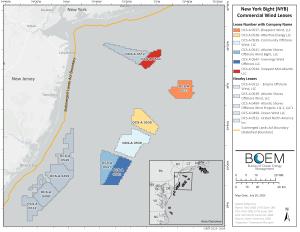As part of the Biden-Harris administration’s goal of deploying 30 gigawatts (GW) of offshore wind energy capacity by 2030, the Bureau of Ocean Energy Management (BOEM) is inviting the public to review and comment on a draft potential development of six wind lease areas offshore New York and New Jersey, in an area known as the New York Bight. BOEM estimates that full development of leases in this area, totaling over 488,000 acres, has the potential to create up to 5.6 to 7 GWs of offshore wind energy, enough to power up to two million homes.
“BOEM welcomes input from diverse stakeholders as we work to meet President Biden’s clean-energy goals that are vitally important to the well-being of the American people,” said BOEM Director Elizabeth Klein. “We look forward to receiving additional public comment to inform this first ever regional environmental review of offshore wind energy development on multiple leases. We are confident that this comprehensive approach can create efficiencies for future project-specific wind energy reviews in a manner that protects the ocean environment and marine life.”
In February 2022, BOEM held an auction that brought in over $4.3 billion for the rights to six lease areas in the New York Bight – a record amount for any U.S. offshore renewable or conventional energy lease sale.
This is the first time BOEM has conducted a regional analysis of offshore renewable energy development and operations over multiple lease areas. BOEM decided to take this additional step to complete a Programmatic Environmental Impact Statement (PEIS) because of the close proximity of the six lease areas and the timing of when BOEM expects to receive future project plans for review.
The Draft PEIS analyzes programmatic avoidance, minimization, mitigation, and monitoring measures that BOEM may require as conditions of its approval for any proposed offshore wind projects in the New York Bight.
This new regional approach is an evolution of BOEM’s process to help ensure timely decisions that advance offshore wind energy development while safeguarding the ocean environment and marine life and reducing conflicts with other ocean uses.
Additional environmental analyses specific to each proposed wind energy project will build off this programmatic review once BOEM receives individual proposed project plans from the leaseholders.
How to Comment
The “Notice of Availability of a Draft Programmatic Environmental Impact Statement for Expected Wind Energy Development in the New York Bight” will publish in the Federal Register on Jan. 12, 2024, which initiates a 45-day public comment period ending on Feb. 26, 2024. During the comment period, BOEM is seeking additional information on important resources and issues, potential impacts to the environment, and programmatic avoidance, minimization, mitigation, and monitoring measures found in the Draft PEIS. BOEM will hold three in-person and two virtual public meetings as follows:
- Jan. 31, 2024, 5:00 p.m. ET – Virtual meeting
- Feb. 5, 2024, 4:00 p.m. ET - North Dartmouth, Mass.
- Feb. 7, 2024, 4:00 p.m. ET - Stony Brook, N.Y.
- Feb. 8, 2024, 4:00 p.m. ET - Toms River, N.J.
- Feb. 13, 2024, 1:00 p.m. ET – Virtual meeting
More information on BOEM’s regional environmental review of the New York Bight, including a map of the six lease areas, how to register for the public meetings, locations of the in-person meetings, and how to provide comments can be found on BOEM’s website: https://www.boem.gov/renewable-energy/state-activities/new-york-bight.
-- BOEM --
The Department of the Interior’s Bureau of Ocean Energy Management (BOEM) is responsible for America’s offshore energy and mineral resources. The bureau promotes energy independence, environmental protection and economic development through responsible, science-based management of energy and mineral resources on the U.S. Outer Continental Shelf.

